If you need convincing that digital transformation is real, it suffices to take a look at the evolutions in the retail industry. Especially since the ‘retail apocalypse’ started about a decade ago, the need to digitize and digitalize, save costs and automate ranked high on the agenda of retail companies.
These cost savings and automation efforts, as we often see in a digital transformation strategy that follows a staged journey, among others, needed to enhance the shopping experience and enable retailers to reinvent themselves. Innovation, changes in business models, ecosystem approaches, the adoption of new technologies, a focus on brand purpose and value, different ways to engage with consumers; they’re all part of this ongoing exercise.
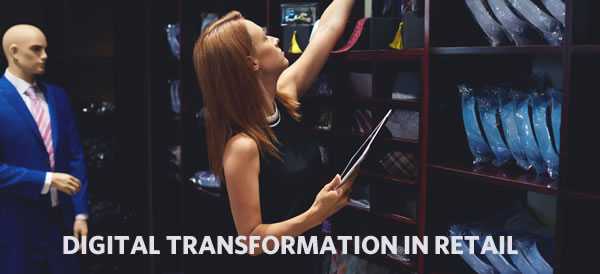
Among the many challenges we saw eroding margins, the growth of e-commerce, declining visits to malls, the success of low-cost retailers, changing consumer behavior/needs, the list is endless.
As if that wasn’t enough, the crisis caused by COVID-19, which came after this article was originally posted, is still in full development. For thoughts and findings on the additional challenges which will be essential in the coming years in the context of that crisis, you might want to check our article on the acceleration of data-driven retail in a holistic sense.
While many once-leading retailers have disappeared and more brands are in peril, often already since before the pandemic, others manage to survive, and some even continued to thrive.
The importance of a clear focus on people (beyond the omnichannel experience of shoppers and staff safety), purpose, and performance in retail has increased as the shift to platform models accelerates and necessitates a data-driven retail model on all levels of the business.
In this overview, we look at some significant evolutions that have been happening for several years in the retailing business. We also point you to additional articles on the digital transformation of retail, what sets winning retailers apart, the technologies being increasingly leveraged in retail, and – last but not least – the changing face and role of stores and retail facilities in a fast-changing world where the consumer is way more than the king. To quote Gerry McGovern from an older interview: “The customer isn’t king anymore; the customer is a dictator.” Retailers know.
Retailers have been experimenting with myriad of ways to respond to new shopper expectations, bridge digital and physical shopping experiences and try literally dozens of ways to transform the retail experience, handle back-office processes better and much more.
Several chains have opened concept stores to see how consumers are interacting with specific technologies and services before rolling them out to more stores. It’s safe to say that the retail industry is among the industries that are most affected by digital business transformation for several reasons as they shift towards more service-oriented models, with many traditional functions, processes and operations being automated.
Drivers of digital transformation in the retail industry
Among the key drivers of digital transformation in retail are:
- The evolving expectations from the so-called digital or omni-channel shopper who really doesn’t care about channels as much as we do.
- The need to blur digital and physical experiences with in-store experiences as a crucial element and the de facto disappearance of the borders between digital and physical already existing in the mind of the consumer and further enabled by the Internet of Things and the immersive experiences in virtual and augmented reality.
- Challenges on the level of the supply chain which is really crucial and all too often far from digitized enough. Speed, time and a transparent view are key.
- Competition from digital and overall customer experience champions and increasing cost pressure. Fortunately, thanks to new digital possibilities, there are ample ways to decrease costs, among others on the level of digitization and supply chain.
- The impact and opportunities in areas such as data-driven optimization and marketing, empowerment of staff and new technologies.
- An appetite from shoppers to have a personalized experience, which is pretty hard to achieve as it depends on the context and can range from the need to find and buy things fast to the exact opposite: have a relaxed and immersive shopping experience with digital technologies available all over the place and used for anything from smart displays to even music and ambiance.
- The uncertainties brought upon us by the COVID-19 pandemic which are seriously impacting the retail industry. One thing, however, is already clear: transformation and several data-driven and IoT-enabled retail solutions (essentially anything enabling to leverage data to optimize the business, make shoppers feel safe, protect workers, save/manage costs, and even potentially decide on which retail stores to close) play a major role here.
By 2023, the 50% of retailers that have linked self-service technology strategy to digital transformation will see a 35% increase in net margin, 10% increase in customer loyalty, and 5% decrease in staff turnover (IDC)
Retail and the consequences of changing consumer behavior
However, as often the digital transformation needs mainly come from a changed behavior – here in people’s capacities as shoppers. We tend to call them ‘digital consumers‘ although that’s not correct.
Today’s shopper is not digital, he still overwhelmingly likes to shop in a store. Knowing that 90 percent of all retail sales transactions occur within the store, why would we then care about the digital behavior of that so-called digital consumer?
90 percent of pre-purchasing research happens online and 90 percent of people use their smartphones in stores while they shop.
Because the ‘digital consumer’ essentially is a consumer who displays changing BEHAVIOR, regardless of the tools or channels or experiences they use and seek.
Drivers and evolutions regarding changing shopping and retail behavior
A channel-agnostic shopping journey.
The use of digital tools and channels across each possible stage of the shopping journey.
This has a consequence on typical pre-shopping tasks (seeking products or shops, comparing, reading reviews,…), the actual shopping transaction (in-store, via digital platforms,….) and post-shopping (word-of-mouth, reviews, customer service, future purchases,…).
Seamless – and immersive – experiences.
The expectations of a seamless customer and shopping experience across multiple touchpoints and channels, whereby the consumer displays so-called omni-channel behavior and seeks experiences that are as easy, fast and frictionless – but sometimes immersive – as offered by the best-in-class retailers and other companies.
Innovation as a new expectation.
The growing demands of consumers for innovative shopping possibilities and experiences that stretch beyond excellence but are unique and satisfy the need that many consumers clearly have for innovative brand and shopping experiences BEYOND excellent customer experience.
Rapid access to information.
The information and service expectations shoppers have from store staff. The need for information about products and shops are obvious in a digital context. However, your shopper also wants fast information in an in-store context and that has an impact on your staff and on the need to empower it with the proper tools and resources.
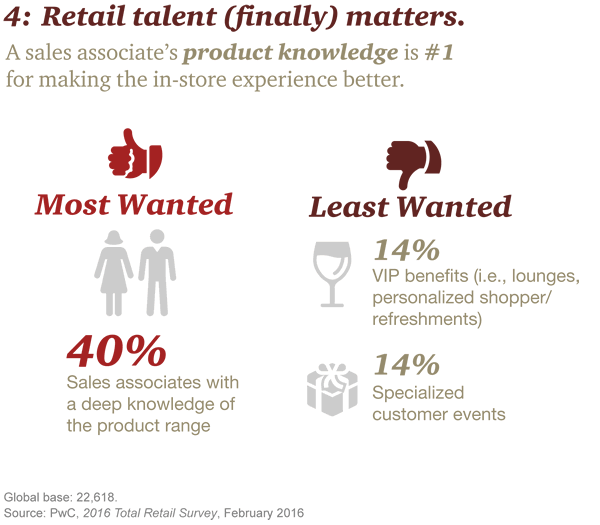
Self-service.
Shoppers are getting used to self-service, self-checkout and finding information and support themselves.
It is expected that by 2017 half of all transactions will happen via mobile POS or self-checkout. The challenge is that not everyone is as keen about self-anything and in many cases a personal contact is prefered, for instance in an urgent service context or when seeking information about products. Refering to the previous point on information, there is a case to not just empower your store’s staff but also to move information self-service tools to touchpoints where they create most value, enabling shoppers to inform themselves easily. Such information resources typically contain information on product features, whether products are in stock (and if not, where or when they are, information on rebates etc.).
Mobility.
Retail customers use digital tools in several stages of the shopping journey, even if 90 percent of in-store transactions happens online.
Millennials today are the largest consumer group and account for an expected $1.4 trillion in spending power. They use omni-channel shopping tools, look up product information before visiting a store or buy online, want convenience and personalized experiences, and prefer socially-conscious brands (Marine Petry)
A significant part of these tasks are performed using a mobile device and on the go. Moreover, when in your store, a significant percentage of shoppers gets out their smartphones to perform various tasks whereby the lines between digital and physical dissapear thanks to consumers’ “mobile ability“.
Digital ubiquity and personalized contextual relevance in retail
Let’s take a step back and look at the impact of this changing behavior from a broader and customer-centric perspective in two areas.
Digital without limits and limitations
A first picture that emerges is one of digital ubiquity, also in the in-store context.
Some facts that make this more tangible:
- At one or the other point in the shopping process, people use the Internet, regardless of devices. 90 percent of pre-purchasing research for instance happens online and 1 in 3 consumers start their shopping journey on a retailer’s website, again regardless of devices.
- A whopping 90 percent of people use their smartphones in stores while they shop. 54 percent performs price comparisons while in your store, 48 percent looks up product information and 2 percent checks reviews online. You can find more similar data in the infographic from BT (a partner), embedded below.
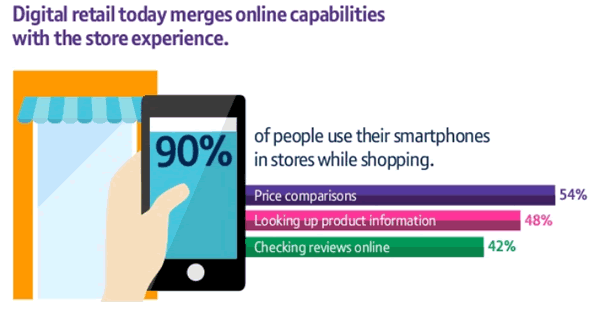
Personalized in-store, digital and omnichannel relevance
A second picture that emerges is one of personalized contextual relevance.
Consumers want more engaging and personalized in-store experiences.
Buyers have more ways to inform themselves, buy, seek service and perform any task in the retail journey than before. That much is clear. If a retailer wants to succeed it’s not just about delivering upon the earlier mentioned expectations.
Each shopper is different. Each shopping journey is different. Last but not least, all the psychological, situational, intentional and contextual factors are different.
You don’t know how a shopper will start his retail buying journey. Is he looking for a product that matches his needs by typing in a search query in Google to find products responding to his needs? Does he know where he can find the product he’s seeking for? Is he extremely informed and just wants to find the fastest and/or cheapest and/or more convenient route to getting what he wants?
The same questions regarding the individual shopper intent and preferences arise in other retail contexts. Personalization is a goal all retailers should try to achieve. Beware though, personalization shouldn’t be a fancy name for harassing people with more messages in a marketing context.
It first and foremost is a matter of enabling shoppers to reach their goals, regardless of the shopping stage they’re in and of making each step in the retail journey as easy, convincing and effective as possible.
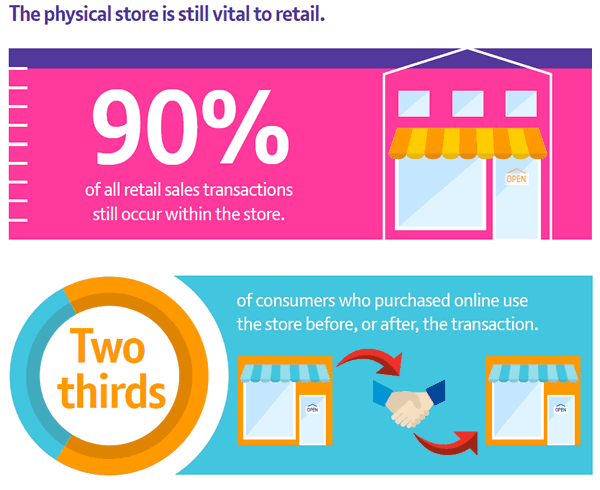
Digital transformation in the retail industry: technologies
Research by OVUM (PDF opens) indicated that managing customer engagement is the biggest challenge for retailers and shows how technology is changing the way we shop.
When asked about how technology will change the shopping experience by 2020, a range of technologies is mentioned, from smart fitting rooms, low-energy Bluetooth devices enabling multiple goals in areas such as payments, floor space management and interactive signage to RFID deployed at item level, ‘whole trolley/basket’ checkout and financial services for known customers. It’s clear that IoT in retail will play a key role, also in the context of that hyper-personalization.
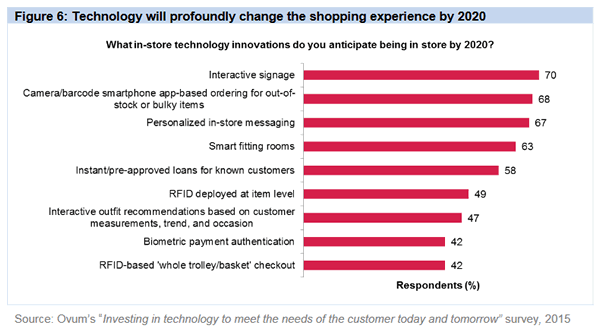
Here is one conclusion from the report: “retail is one of the most rapidly changing verticals across the world and is often at the forefront of technological advancement to keep pace with the evolving needs of a 24/7 customer base”. We can add ‘hungry for innovative experiences’ to that customer base. How hungry exactly and which innovative experiences are appreciated most is being learned in innovation centers and real-world test and concept stores across the globe.
They often occur in collaboration partnerships between IT service providers and retailers. It is said that the digital transformation economy almost by definition is one of partnerships. It is more than ever about collaboration with partners who test new technologies and experiences in retail.
Obviously we can’t forget the crucial role of big data. Data is the new oil in retail (too) and is key in many areas as depicted below in the image from an infographic by ADITI, uploaded by Harman Services.
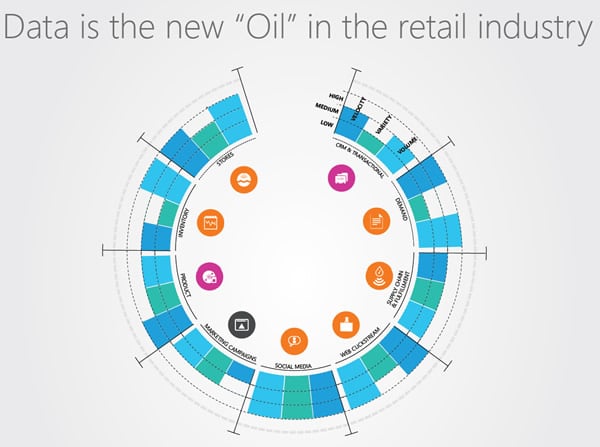
It also mentions the critical role of the cloud and gives some good examples of retailers and how they navigate(d) digital transformation. Obviously we see all pillars of the third platform (big data/analytics, social, mobile and cloud) playing a big role in retail as are new technologies added upon that layer such as the Internet of Things and artificial intelligence or cognitive if you like.
Research, data and findings regarding the state of digital transformation in retail
A broad range of research by independent companies, consultancies and vendors confirms most of the mentioned evolutions.
In its Total Retail Survey 2016 report, PwC among others found that:
- The global retail landscape is changing rapidly, mainly e-commerce with the likes of Amazon growing fast as you know and traditional brick-and-mortar retailers seeing serious drops in revenues, caused by digital disruption, defined as the speed of adoption of new technologies, as John Maxwell puts it in in the video you can see on the page of the report and which we used for this small list of findings.
- Convenience is important but price is still king. Clear. Both matter a lot but with the role of price costs are a challenge. What if convenience and price could be optimized with digital transformation? Guess what: they can.
- The in-store customer experience matters even more than in the past, with consumers wanting more engaging and personalized experiences. With store traffic down, the emphasis is on conversion.
- Knowledge is essential: 40 percent of respondents say that sales associates with deep knowledge of the product range are important for them (and you can add knowledge of other retail-related information such as inventory status).
- Social media and peer opinions have a key influence on buying decisions and perceptions of brand authenticity with 45 percent of respondents saying that reading opinions and comments influence their shopping behaviors (and they are willing to share opinions themselves).
- Mobile commerce is big and mobile shopping is becoming the shopping tool of choice. Mobile shopping increased 8 percent last year and 34 percent of respondents agree that their mobile phone will become their main purchase tool.
More in the mentioned video. On the same page you’ll find 4 more videos that, respectively, zoom in on mobile shopping, social media, millennials and our personal favorite: the in-store experience.
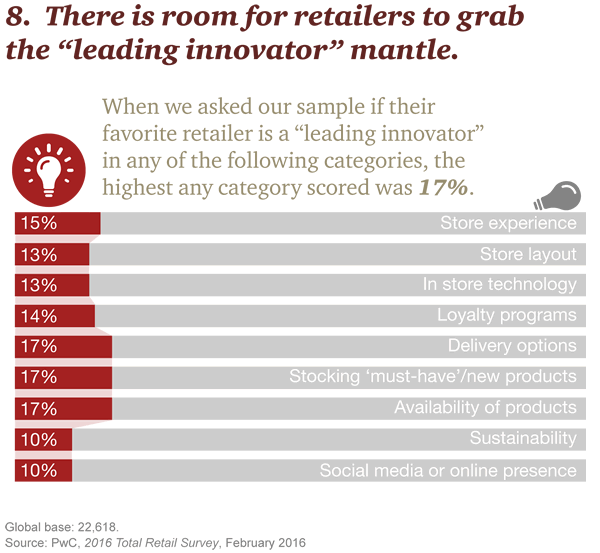
In regards with the latter it’s interesting to see what makes consumers see their favorite retailers as a leading innovator: store experience, store layout, in-store technology, delivery options and sustainability all play a role on top of more traditional aspects many would expect such as loyalty programs.
The room to innovate is there as is the reality of digital transformation.
More articles on the evolutions and transformations in the retail industry:
- Retail innovation and transformation – what winning retailers do better
- The acceleration of data-driven retail on the road to recovery
- Retail facilities: an integrated retail facility management approach
- The Internet of Things (IoT) in the retail industry – evolutions and use cases
- Retail Systems Research: IoT in retail – between belief and barriers
Infographic: the modern retailer: from transition and transformation to innovation.

Top image: Shutterstock – Copyright: GaudiLab

